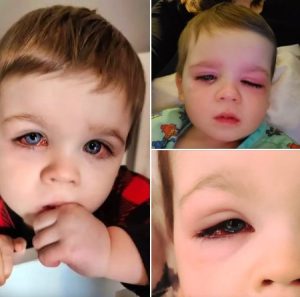For most young children, the end of the day usually means one thing—bath time. And for many families, it’s a moment filled with giggles, splashing, and colorful bath toys that make the experience even more enjoyable. But for one mother in Illinois, bath time turned into a terrifying ordeal that nearly cost her 2-year-old son his eyesight. Her story has become a powerful reminder to parents everywhere that some of the most innocent-looking toys can hide serious dangers.

Eden Strong was just going through her usual evening routine with her toddler son, Baylor. As she bathed him, she noticed something a bit off—his eye seemed irritated. At first, she didn’t think much of it, assuming that maybe a bit of soapy water had gotten into his eye during the bath. It’s a common enough occurrence and usually clears up on its own. But this time, things took a dramatic and horrifying turn.
Shortly after his bath, Baylor’s eye became more inflamed, and his discomfort intensified. Within hours, it was clear that something was seriously wrong. His eye went from looking slightly pink to dangerously infected in just twelve hours. Eden rushed him to the hospital, terrified by what she saw. “His eye was protruding from his face,” she wrote in a heartfelt Facebook post. “It was very obscured. He was running a raging fever.”
The diagnosis: cellulitis—a severe and potentially life-threatening bacterial skin infection. For Baylor, it had settled in his eye and was spreading rapidly. Eden described the following week as one of the most frightening periods of her life. “I cried the entire drive to a larger hospital, praying that he wouldn’t lose his eye,” she said. The infection worsened quickly, spreading not only across his face but eventually affecting both of his eyes. Doctors warned Eden that Baylor might lose vision in the worse-affected eye. It was a grim possibility no parent wants to face.
Thankfully, after intense medical treatment, Baylor’s eyes began to heal. “Thank the Lord his eyes healed,” Eden shared in her post. “But it was a very close call, and one that could have ended very differently.”
So what caused such a severe infection? The answer shocked Eden—and it’s stunned hundreds of thousands of parents since. The culprit was a simple squirting bath toy.
Eden later discovered that these types of toys—soft, squeezable bath figures that shoot out water—can harbor dangerous bacteria. Because they are designed to fill with water and squirt it out, they often retain moisture inside. Over time, this moist environment becomes a perfect breeding ground for bacteria and mold. And since they are nearly impossible to clean thoroughly, harmful microorganisms can grow inside without being visible from the outside.
“I came to find out later that because the water is never fully expelled from those types of toys, they can just grow bacteria that you can’t stop,” Eden explained. Her warning, combined with photos of Baylor’s injured face and eye, quickly went viral. Her post has been shared over 320,000 times on Facebook and received an outpouring of responses from other parents who had experienced similar issues with bath toys.
Many people sent her messages and photos of their children’s injuries caused by bacteria-infested bath toys. Some were minor skin rashes, but others were more severe, with infections that required medical intervention. It was a shocking realization that something so small and seemingly harmless could pose such a significant risk.
Eden’s story has sparked a much-needed conversation about the safety of children’s bath toys. She hopes that toy manufacturers take note and begin to reconsider how these products are designed. “I think those toys especially are cute. They’re fun. They’re cheap and they’re easy,” she said. “But it’s not worth it.”
Since Baylor’s ordeal, Eden has thrown out all of her son’s squeezable bath toys and encourages other parents to do the same. While it might seem like a small precaution, eliminating toys that trap water could prevent future injuries and infections in countless children.
Her warning isn’t meant to instill fear, but rather to raise awareness. Most parents, understandably, don’t think twice about the toys their children play with in the tub. But Eden’s story is a powerful example of why it’s important to take a closer look at the items we trust around our children. Especially when it comes to products that interact with water and are used repeatedly without proper drying or cleaning.
Parents across the country are now reconsidering the types of toys they allow in the bathtub. Pediatricians and health experts are also urging families to be cautious and avoid any toy that can trap water inside, especially if it’s difficult to disinfect.
Ultimately, Eden’s transparency and bravery in sharing her family’s painful experience has likely helped prevent future injuries. Her willingness to speak out, despite how difficult it was to revisit the trauma, has made a real impact. Her story is a call to action—not just for parents, but for toy designers and manufacturers to think more carefully about safety in every product made for children.
What happened to Baylor was terrifying, but thanks to prompt medical care and his mother’s vigilance, he recovered. The experience, however, left a lasting impression—not only on their family but also on hundreds of thousands of people who read and shared their story. It serves as a sobering reminder that sometimes the biggest dangers come in the smallest packages.
If you’re a parent, grandparent, or caregiver, please take this warning seriously. Check your child’s bath toys. If they trap water and can’t be cleaned inside, consider tossing them out. The safety of our children is worth far more than a few minutes of bath-time fun. Please share this story to help spread the word and protect other families from going through what Eden and Baylor experienced.





